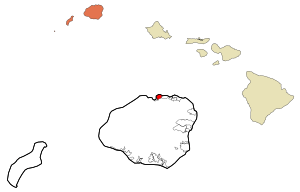Princeville, Hawaii facts for kids
Quick facts for kids
Princeville, Hawaii
|
|
|---|---|

Princeville from the Kilauea Point National Wildlife Refuge
|
|

Location in Kauai County and the state of Hawaii
|
|
| Country | United States |
| State | Hawaii |
| County | Kauai |
| Named for | Prince Albert Kamehameha |
| Area | |
| • Total | 2.65 sq mi (6.85 km2) |
| • Land | 2.60 sq mi (6.74 km2) |
| • Water | 0.04 sq mi (0.12 km2) |
| Elevation | 194 ft (59 m) |
| Population
(2020)
|
|
| • Total | 2,157 |
| • Density | 829.30/sq mi (320.17/km2) |
| Time zone | UTC-10 (Hawaii-Aleutian) |
| ZIP codes |
96714, 96722
|
| Area code(s) | 808 |
| FIPS code | 15-65075 |
| GNIS feature ID | 1867259 |
Princeville is a beautiful area on the north shore of Kauai, an island in Hawaii, United States. It's a large community with many homes and condos, covering about 9,000 acres (3,642 hectares). It's not an official city but a special kind of community called an unincorporated area and a census-designated place. In 2020, about 2,157 people lived there.
Where is Princeville?
Princeville is located at 22°13′25″N 159°29′7″W. It's the most northern settlement in the entire state of Hawaii!
This community covers about 2.4 square miles (6.2 square kilometers). Most of this area is land, but a small part, about 0.3 square miles (0.8 square kilometers), is water.
Princeville's Past
Princeville got its name in 1860. It was named after Prince Albert Kamehameha. He was the son of King Kamehameha IV and Queen Emma. The area was then a large farm, known as a plantation. It was owned by a man named Robert Crichton Wyllie.
At first, coffee plants were grown here. But the wet, low-lying land wasn't good for coffee. So, the land was later used to grow sugarcane. After some time, it became a cattle ranch.
In 1968, the land was sold for development. It was turned into a golf course and a resort. This new resort was called Princeville at Hanalei.
People of Princeville
| Historical population | |||
|---|---|---|---|
| Census | Pop. | %± | |
| 2020 | 2,157 | — | |
| U.S. Decennial Census | |||
In 2020, the population of Princeville was 2,157 people. This number has grown over the years. For example, in 2000, there were 1,698 people living here.
Images for kids
See also
 In Spanish: Princeville (Hawái) para niños
In Spanish: Princeville (Hawái) para niños



